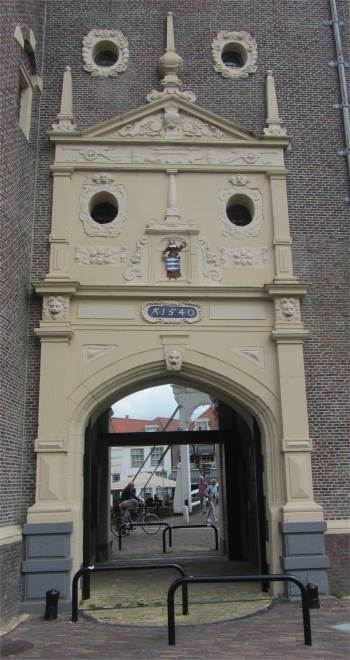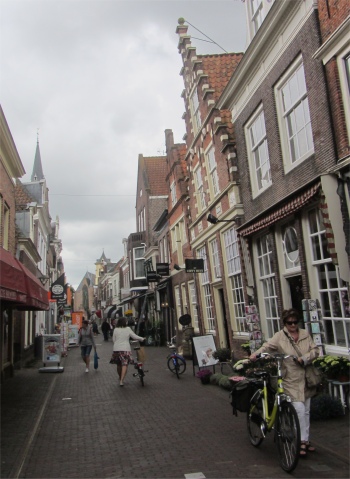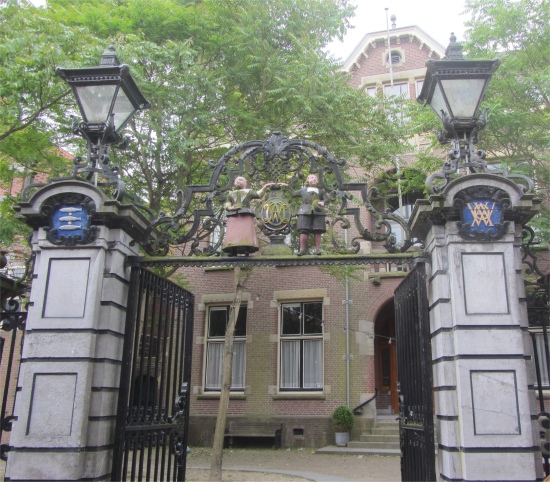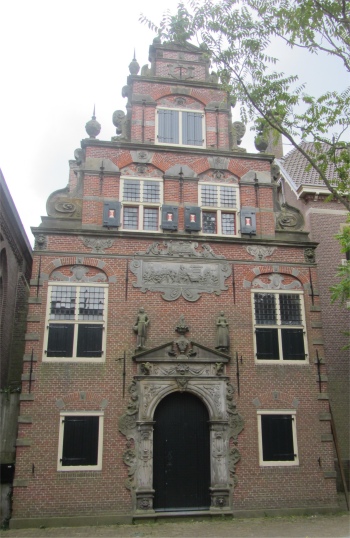Our ferry was ploughing a furrow between amassed ships at anchor, with a couple of cargo ships close on our track as we headed into the confines between Europoort and the Hoek. Other cargo ships passed close by on their way out to sea.
Soon our ferry was slowly heading up to a long quay, and despite the ferry's size, delicately pulled up alongside and gracefully berthed - a marvellous operation to watch.
The train network at the Hoek was being restructured, so we had to take a bus to Schiedam Centrum (quite near to Rotterdam), the nearest train station. From there it was a train to Leiden where we got a connection to Amsterdam Sloterdijk, and finally a train to Enkhuizen where Barry and Yvonne had left the boat. Conveniently they had moored
Duonita in the Buyshaven, right next to the train station.

Drommedaris Gate
|

Westerstraat
|
Over a cup of tea we continued our ongoing discussion on how we intended to reach Denmark. We soon converged on the idea of sailing up the Ijsselmeer to the Kornwerderzand Sluis, then up a narrow channel to Harlingen. The options open to us on reaching Harlingen were closing down due to very unsavoury weather heading our way. One option would be to cross the Waddenzee and squeeze through between the two Frisian Islands of Vlieland and Terschelling to reach the German Bight. To make the best use of tidal ebbs, we would need to head off around 6am, hopefully entering the German Bight 12 hours later. That would be the elegant option, but it required very good weather conditions. The literature indicated that the Waddenzee and the gat between the islands can be very treacherous indeed, particularly if the wind had a northern component. An alternative, slower option would be to travel along the canals from Harlingen through the Friesland and Groningen provinces and break out into the German Bight further along. The outlook did not look good, and this was soon coupled with the input from the Dutch chap in the boat moored next to us, advising that the Ijsselmeer can turn very rough in windy conditions.
To get the latest local input on the weather outlook, we walked up to the harbour-master's office. The master was a jovial chap who kindly printed out the latest weather predictions, which sadly did not match his jollity.
We wandered back to the boat to chew over all the intelligence we had to hand. The most sensible conclusion we reached was we would stay put the next day since Force 5s were predicted, then we would head up to Harlingen. Once there we would reconsider our options based on the latest weather forecasts we could obtain up there.

Attractive Gateway
|
With that agreed, we headed to town to purchase supplies to keep us going at sea should we make it.

Weeshuis
|
Enkhuizen was formerly known as the Herring City because of its long association with the herring fishery. It was the administrative center of Friesland until 1289, when western Friesland became part of the County of Holland. Count Floris V granted the town its municipal charter in 1355, and thereafter it began to flourish. It was one of the harbour-towns of the VOC, just like Hoorn and Amsterdam, from where overseas trade with the East Indies was conducted. The town walls were built around 1550 and strengthened in the early 17th century. Enkhuizen was one of the first towns to revolt against Spanish rule in 1572. Its ships, along with those of Hoorn, Edam and Monnickendam, took part in the naval battle in October 1573 in which a Spanish fleet commanded by Admiral Bossu was defeated. The population fell sharply after an outbreak of plague in 1636. In the mid-17th century, Enkhuizen was at the peak of its power and was one of the most important harbour cities in the Netherlands. However, due to a variety of reasons, notably the silting up of the harbours, Enkhuizen lost its position to Amsterdam.
The Drommedaris tower still stood as proud as ever, a relic of the town's fortifications (1540). The tower, which was heightened in 1649, has a carillon by the Hemony brothers which ranks among the finest in the Netherlands. It served at one time as a prison, and some of the cells can still be seen. Here the history of the East India Company, known as VOC, in Enkhuizen is still clearly visible. The VOC was in the 17th and 18th centuries the largest trading company in the world, and its magnificent ships travelled to Asian countries to trade. The convenient location on the Ijsselmeer made it an attractive to settle. A "Chamber of the VOC", The Drommedaris, the defence tower on the harbour, and the centre of the historic buildings, reminded us of this prosperous time. We passed by it, over the little bridge, and walked up by the Oude Haven, a charming area of town, with boats tied up to the quayside, and a mixture of small businesses, restaurants, cafes and residential properties lining the quay. We wanted to check out the excellent
Markerwaard restaurant that we fell in love with when we were
here in 2013. Sadly it had been turned into a tapas bar; such a shame.

St Gomaruskerk and Bell Tower with Verger's House between Them
|
We strolled down Westerstraat, gazing at the incredible leaning buildings, looking as though they would collapse onto the street at any minute, and paused to marvel again at the tall wooden bell tower next to the 400 year old St Gomaruskerk, a Gothic hall-church with timber vaulting not quite as tall as the nearby St Pancraskerk. A small building, the Verger's House, with a fine stepped gable of 1600, stood between the wooden tower and the church. A tall Dutch fellow (most Dutch fellows are tall) spotted us admiring this small building, and he explained that it used to be a jewellers and clock maker's house at one time. The last time we were here a young Dutch woman had explained that the wooden bell tower was built after the church was completed, and wood was chosen for its construction since almost all the funding had been used in building the church. "Why didn't they put the bells on top of the church?" I had asked, naively. "We do not have stone like you do in England, our buildings were made of brick, and the construction of a bell tower on top of the church would have been very difficult considering the weight of the bells," she explained. When I thought about it, she was quite correct, most old buildings I had seen were made from brick. "This church was paid for by the farmers. The other church (St Pancraskerk) was paid for by the fishermen, and is 75m tall so that they could sight it from their boats way out in the Zuiderzee at the time it was built," she had added. I found out later that the bell tower, originally built in 1519, was renovated in neo-classical style in the 19th century, with a wooden facing. Now we had to get down to work buying provisions.
In the evening we dined at t'Ankertje pub which stood by the Oude Haven opposite the Drommedaris Tower. The inside of this charming pub/restaurant resembled an old curiosity shop, with old ship models, floats, dead-eyes and a host of other sailing memorabilia hanging from the ceiling.
A young fellow served us a Texel beer, not unlike a wheat beer, but it had a kick to it. Later I opted for the Alex Ankertje beer, less like a wheat beer but still possessing a kick like a mule. We had no idea what the strength of these ales was. The food was delicious, and we shared humour with the staff.
For some unknown reason, the table behind us was where the staff sat a series of young German male customers. What I found most odd was that although German is akin to Dutch, the Germans adamantly spoke only in English with the Dutch.
We settled down for the night with the wind howling through
Duonita's shrouds.







